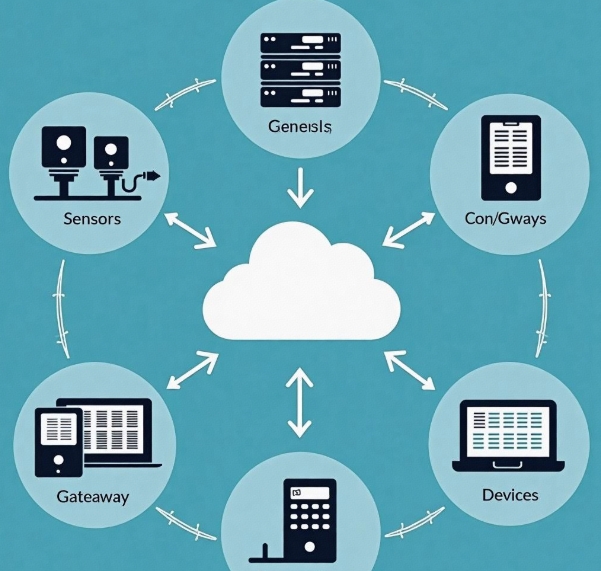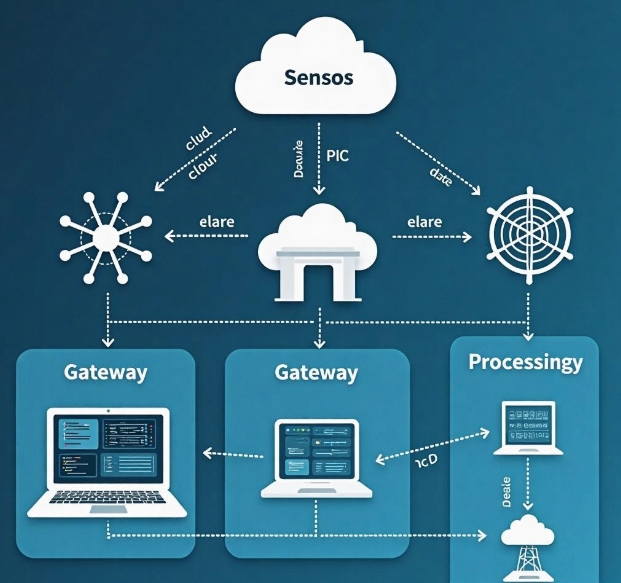Network Optimization and Latency Management in IoT Development
- latest articles
- 1.DApp Development & Customization: Merging Diverse Market Needs with User Experience 2.Analysis of the Core Technical System in DApp Project Development 3.How to achieve cross-chain interoperability in Web3 projects? 4.How does the tokenization of points reconstruct the e-commerce ecosystem? 5.How to Set and Track Data Metrics for a Points Mall? 6.What is DApp Development? Core Concepts and Technical Analysis 7.Inventory of commonly used Web3 development tools and usage tips 8.Development of a Distribution System Integrated with Social E-commerce 9.Six Key Steps for Businesses to Build a Points Mall System 10.What is DApp Development? A Comprehensive Guide from Concept to Implementation
- Popular Articles
- 1.Future Trends and Technology Predictions for APP Development in 2025 2.Analysis of the DeFi Ecosystem: How Developers Can Participate in Decentralized Finance Innovation 3.From Zero to One: How PI Mall Revolutionizes the Traditional E-commerce Model 4.DAPP Development | Best Practices for Professional Customization and Rapid Launch 5.How to Develop a Successful Douyin Mini Program: Technical Architecture and Best Practices 6.Recommended by the Web3 developer community: the most noteworthy forums and resources 7.From Cloud Computing to Computing Power Leasing: Building a Flexible and Scalable Computing Resource Platform 8.Shared Bike System APP: The Convenient Choice in the Era of Smart Travel 9.How to Create a Successful Dating App: From Needs Analysis to User Experience Design 10.From Design to Development: The Complete Process of Bringing an APP Idea to Life
With the rapid development of Internet of Things (IoT) technology, an increasing number of devices are interconnected through the internet, forming a vast and complex network. The application areas of IoT span across smart cities, smart homes, industrial automation, and many other industries, greatly driving progress in various sectors. However, the rapid advancement of IoT also brings challenges in network optimization and latency management. Ensuring low latency, high reliability, and efficient resource utilization within such a massive network of devices has become a critical challenge in IoT development.
In IoT systems, the sheer number of devices, massive data traffic, and complex network topologies mean that network quality and latency directly impact system performance and user experience. Therefore, effective network optimization and latency management are among the core issues that must be addressed when developing IoT applications.
I. IoT Network Architecture and Its Challenges
The network architecture of IoT typically consists of sensors, actuators, gateways, and cloud servers. These devices communicate via wired or wireless networks, generating massive data flows. However, the characteristics of IoT networks present numerous challenges:
Massive Number of Devices: The number of IoT devices often reaches billions, making communication demands extremely complex. During data exchange, network bandwidth and throughput often fall short of requirements.
Complex and Variable Network Environments: IoT devices are distributed across diverse environments such as urban, rural, indoor, and outdoor settings, leading to significant variations in network quality, including issues like signal loss and excessive latency.
Low-Power Devices: Many IoT devices are designed for low power consumption, requiring network designs to consider not only communication efficiency but also battery life and energy efficiency.
High Real-Time Requirements: Many IoT applications, such as intelligent transportation systems, industrial automation, and telemedicine, require real-time data transmission and processing. Even slight delays can lead to system failure or degraded user experience.
Large-Scale Concurrent Communication: In IoT, devices often generate large amounts of data simultaneously, and the number of devices continues to grow. Ensuring that concurrent communication among multiple devices does not cause network congestion is another urgent problem to solve.
Therefore, network optimization and latency management are particularly important in IoT development.
II. Network Optimization Strategies in IoT
Adaptive Network Scheduling
In IoT applications, devices and network environments are constantly changing, so network scheduling needs to be adaptive. Adaptive network scheduling can dynamically adjust the allocation of communication resources based on device transmission needs and network conditions. For example, using a dynamic bandwidth allocation mechanism based on network load can allocate more bandwidth during periods of high device traffic to ensure network stability and smoothness.Data Compression and Distribution Strategies
For the large amounts of data generated by IoT devices, data compression techniques can reduce the size of transmitted data, thereby lowering network bandwidth consumption. Additionally, employing appropriate distribution strategies to route data to suitable nodes or servers for processing can effectively reduce latency. For instance, using edge computing technology to push data processing tasks closer to the data source or edge nodes avoids excessive central processing and reduces latency.Adoption of 5G and Low-Power Wide-Area Network (LPWAN) Technologies
Traditional network technologies like Wi-Fi or Bluetooth have certain bandwidth limitations in IoT, whereas 5G and LPWAN technologies provide a more stable network environment for IoT. The low latency and high-speed transmission capabilities of 5G networks can meet the demands of more real-time application scenarios. Meanwhile, LPWAN technology effectively enhances the communication efficiency of low-power devices and extends their battery life.Edge Computing and Cloud Computing Collaboration
Edge computing pushes data processing to the network edge, significantly reducing network latency by shortening data transmission distances and loads. Cloud computing, on the other hand, provides powerful data processing and storage capabilities. Through the collaboration of edge and cloud computing, network traffic can be further optimized, and network burden reduced, while ensuring system performance.Optimized Routing Protocols
In IoT, due to the vast number and wide distribution of devices, efficient data transmission is key to network optimization. Optimized routing protocols can select the best transmission paths based on factors such as network topology, signal strength, and device location, reducing unnecessary routing hops and network latency. Common optimized routing protocols include AODV (Ad hoc On-demand Distance Vector) and OLSR (Optimized Link State Routing).
III. Latency Management in IoT
Latency is one of the critical factors affecting system performance in IoT. Latency management is not just about optimizing data transmission speed; it is essential for ensuring the system can respond to and process user demands within specified timeframes. Sources of latency typically include the following aspects:
Propagation Delay: Refers to the time it takes for a signal to travel through the transmission medium, usually related to the signal's propagation speed and distance. IoT devices are widely distributed, especially in remote or extreme environments, where propagation delay can be significant.
Processing Delay: Refers to the time required for a device to process data and make decisions after receiving it. In complex data analysis tasks, processing delay often becomes a bottleneck affecting the overall system response speed.
Queueing Delay: When device or network traffic is too high, data packets queue up for processing, leading to increased delay. Queueing delay typically occurs at intermediate nodes like routers or switches.
Buffering Delay: When multiple devices or users simultaneously request data transmission, the network's queuing capacity becomes a key factor in delay. Effective traffic control and load balancing mechanisms can alleviate buffering delay issues.
To effectively manage latency, IoT systems can adopt the following measures:
Real-Time Monitoring and Adaptive Adjustment
By monitoring the network and devices in real time, abnormal latency situations can be promptly detected, and corresponding adaptive adjustment strategies can be implemented. For example, when latency is too high, dynamically adjusting data transmission frequency or selecting shorter transmission paths can ensure the system completes tasks within the required time.Distributed Computing and Data Caching
Through distributed computing, IoT systems can distribute computational tasks across multiple nodes, reducing the processing pressure on any single node and effectively lowering latency. Additionally, data caching technology can store frequently accessed data locally or at edge nodes, reducing the delay of remote data access.Optimized Transmission Protocols
In IoT, many devices use communication protocols that may have latency issues. For example, traditional HTTP is not suitable for applications with high real-time requirements. To reduce latency, protocols specifically designed for IoT, such as MQTT (Message Queuing Telemetry Transport) and CoAP (Constrained Application Protocol), can be adopted. These protocols minimize latency while ensuring stable data transmission.Priority Scheduling and Bandwidth Allocation
In networks, different types of data have different priorities. For data with high real-time requirements, such as in telemedicine or intelligent transportation, priority scheduling mechanisms can ensure these data packets are transmitted first. For data with higher tolerance for delay, transmission can be appropriately delayed, thus effectively managing latency.
IV. Conclusion
Network optimization and latency management in IoT are complex and crucial topics. As IoT applications become increasingly widespread, ensuring network efficiency and low latency is a challenge that developers and system designers must face. By adopting advanced network technologies, adaptive scheduling, data compression and distribution, edge computing, optimized routing protocols, and other methods, the performance and response speed of IoT networks can be effectively enhanced.
However, network optimization and latency management in IoT are not achieved overnight; developers need to flexibly choose appropriate strategies based on specific application scenarios and technical environments. In the future, with the continuous development of new-generation communication technologies (such as 5G and 6G) and intelligent algorithms, IoT network optimization and latency management will see more diverse and efficient solutions, further promoting the widespread application and adoption of IoT technology.
-

How to Use IoT Development to Enhance Supply Chain Efficiency
With the rapid development of the global economy and the deepening of digital tr···
-

Development and Innovation of the Internet of Things in the Healthcare Sector
With the rapid advancement of information technology, the Internet of Things (Io···
-

Data Storage and Analysis Methods in IoT Development
The Internet of Things (IoT) is one of the most revolutionary innovations in tod···

 Blockchain
Blockchain












